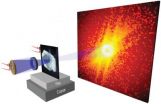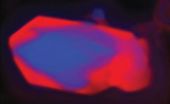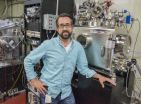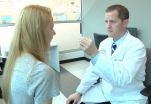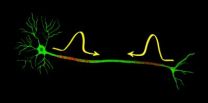(Press-News.org) A record-setting X-ray microscopy experiment may have ushered in a new era for nanoscale imaging. Working at the U.S. Department of Energy (DOE)'s Lawrence Berkeley National Laboratory (Berkeley Lab), a collaboration of researchers used low energy or "soft" X-rays to image structures only five nanometers in size. This resolution, obtained at Berkeley Lab's Advanced Light Source (ALS), a DOE Office of Science User Facility, is the highest ever achieved with X-ray microscopy.
Using ptychography, a coherent diffractive imaging technique based on high-performance scanning transmission X-ray microscopy (STXM), the collaboration was able to map the chemical composition of lithium iron phosphate nanocrystals after partial dilithiation. The results yielded important new insights into a material of high interest for electrochemical energy storage.
"We have developed diffractive imaging methods capable of achieving a spatial resolution that cannot be matched by conventional imaging schemes," says David Shapiro, a physicist with the ALS. "We are now entering a stage in which our X-ray microscopes are no longer limited by our optics and we can image at nearly the wavelength of our X-ray light."
Shapiro is the lead and corresponding author of a paper reporting this research in Nature Photonics. The paper is titled "Chemical composition mapping with nanometer resolution by soft X-ray microscopy." (See below for a full list of co-authors and their affiliations.)
In ptychography (pronounced tie-cog-raphee), a combination of multiple coherent diffraction measurements is used to obtain 2D or 3D maps of micron-sized objects with high resolution and sensitivity. Because of the sensitivity of soft x-rays to electronic states, ptychography can be used to image chemical phase transformations and the mechanical consequences of those transformations that a material undergoes.
"Until this work, however, the spatial resolution of ptychographic microscopes did not surpass that of the best conventional systems using X-ray zone plate lenses," says Howard Padmore, leader of the Experimental Systems Group at the ALS and a co-author of the Nature Photonics paper. "The problem stemmed from the fact that ptychography was primarily developed on hard X-ray sources using simple pinhole optics for illumination. This resulted in a low scattering cross-section and low coherent intensity at the sample, which meant that exposure times had to be extremely long, and that mechanical and illumination stabilities were not good enough for high resolution."
Key to the success of Shapiro, and his collaborators were the use of soft X-rays which have wavelengths ranging between 1 to 10 nanometers, and a special algorithm that eliminated the effect of all incoherent background signals. Ptychography measurements were recorded with the STXM instruments at ALS beamline 11.0.2, which uses an undulator x-ray source, and ALS beamline 5.3.2.1, which uses a bending magnet source. A coherent soft X-ray beam would be focused onto a sample and scanned in 40 nanometer increments. Diffraction data would then be recorded on an X-ray CCD (charge-coupled device) that allowed reconstruction of the sample to very high spatial resolution.
"Throughout the ptychography scans, we maintained the sample and focusing optic in relative alignment using an interferometric feedback system with a precision comparable to the wavelength of the X-ray illumination," Shapiro says.
Lithium iron phosphate is widely studied for its use as a cathode material in rechargeable lithium-ion batteries. In using their ptychography technique to map the chemical composition of lithium iron phosphate crystals, Shapiro and his collaborators found a strong correlation between structural defects and chemical phase propagation.
"Surface cracking in these crystals was expected," Shapiro says, "but there is no other means of visualizing the correlation of those cracks with chemical composition at these scales. The ability to visualize the coupling of the kinetics of a phase transformation with the mechanical consequences is critical to designing materials with ultimate durability."
Shapiro and his colleagues have already begun applying their ptychography technique to the study of catalytic and magnetic films, magnetotactic bacteria, polymer blends and green cements.
For the chemical mapping of lithium iron phosphate they used the STXM instrument at ALS beamline 5.3.2.1 which required up to 800 milliseconds of exposure to the X-ray beam for each scan. Next year, they anticipate using a new ALS beamline called COSMIC (COherent Scattering and MICroscopy), which will feature a high brightness undulator x-ray source coupled to new high-frame-rate CCD sensors that will cut beam exposure times to only a few milliseconds and provide spatial resolution at the wavelength of the radiation.
"If visible light microscopes could only achieve a resolution that was 50 times the wavelength of visible light, we would not be able to see most single celled organisms," Shapiro says. "Where would the life sciences be with such a limitation? We are now approaching the point where we will have X-ray microscopes of comparable quality to today's visible light instruments for the study of nanomaterials."
INFORMATION:
Co-authoring the Nature Photonics paper in addition to Shapiro and Padmore were Young-Sang Yu, Tolek Tyliszczak, Jordi Cabana, Rich Celestre, Weilun Chao, David Kilcoyne, Stefano Marchesini, Tony Warwick and Lee Yang of Berkeley Lab; Konstantin Kaznatcheev of Brookhaven National Laboratory; Shirley Meng of the University of San Diego; and Filipe Maia of Uppsala University in Sweden.
This research was primarily supported by the DOE Office of Science.
Lawrence Berkeley National Laboratory addresses the world's most urgent scientific challenges by advancing sustainable energy, protecting human health, creating new materials, and revealing the origin and fate of the universe. Founded in 1931, Berkeley Lab's scientific expertise has been recognized with 13 Nobel prizes. The University of California manages Berkeley Lab for the U.S. Department of Energy's Office of Science. For more, visit http://www.lbl.gov.
DOE's Office of Science is the single largest supporter of basic research in the physical sciences in the United States, and is working to address some of the most pressing challenges of our time. For more information, please visit the Office of Science website at science.energy.gov/.
Advanced light source sets microscopy record
Berkeley Lab researchers achieve highest resolution ever with X-ray microscopy
2014-09-10
ELSE PRESS RELEASES FROM THIS DATE:
Missing piece found to help solve concussion puzzle
2014-09-10
PITTSBURGH, Sept. 10, 2014 – Researchers at UPMC and the University of Pittsburgh have created a new, 5- to 10-minute test that could be added to a clinician's concussion evaluation toolkit for a more comprehensive assessment of the injury.
In a recent study published online first by the American Journal of Sports Medicine, researchers from the UPMC Sports Medicine Concussion Program demonstrated that clinicians could use their novel Vestibular/Ocular Motor Screening (VOMS) examination to be 90 percent accurate in identifying patients with concussion. The VOMS, which ...
Nerve impulses can collide and continue unaffected
2014-09-10
According to the traditional theory of nerves, two nerve impulses sent from opposite ends of a nerve annihilate when they collide. New research from the Niels Bohr Institute now shows that two colliding nerve impulses simply pass through each other and continue unaffected. This supports the theory that nerves function as sound pulses. The results are published in the scientific journal Physical Review X.
Nerve signals control the communication between the billions of cells in an organism and enable them to work together in neural networks. But how do nerve signals work? ...
Non-dominant hand vital to the evolution of the thumb
2014-09-10
New research from biological anthropologists at the University of Kent has shown that the use of the non-dominant hand was likely to have played a vital role in the evolution of modern human hand morphology.
In the largest experiment ever undertaken into the manipulative pressures experienced by the hand during stone tool production, researchers analysed the manipulative forces and frequency of use experienced by the thumb and fingers on the non-dominant hand during a series of stone tool production sequences that replicated early tool forms.
It is well known that ...
Living liver donors ambivalent with donation
2014-09-10
Living donors are important to increasing the number of viable grafts for liver transplantation. A new study published in Liver Transplantation, a journal of the American Association for the Study of Liver Diseases and the International Liver Transplantation Society, found that ambivalence is common among donor candidates. However, providing social support may help minimize the donors' concerns regarding donation.
There is much demand for organs and a shortage of deceased organ donations. One solution to this shortage is the use of living donors for liver transplantation. ...
How skin falls apart: Pathology of autoimmune skin disease is revealed at the nanoscale
2014-09-10
BUFFALO, N.Y. –University at Buffalo researchers and colleagues studying a rare, blistering disease have discovered new details of how autoantibodies destroy healthy cells in skin. This information provides new insights into autoimmune mechanisms in general and could help develop and screen treatments for patients suffering from all autoimmune diseases, estimated to affect 5-10 percent of the U.S. population.
The research, published in PLoS One on Sept. 8, has the potential to help clinicians identify who may be at risk for developing Pemphigus vulgaris (PV), an autoimmune ...
CNIO successfully completes its fisrt clinical trial on HER-2-negative breast cancer with nintedanib
2014-09-10
The experimental drug nintedanib, combined with standard chemotherapy with paclitaxel, causes a total remission of tumours in 50% of patients suffering from early HER-2- negative breast cancer, the most common type of breast cancer. These are the conclusions of the Phase I Clinical Trial, sponsored by the Spanish National Cancer Research Centre (CNIO) and carried out by CNIO ́s Breast Cancer Clinical Research Unit. The study has been published today in British Journal of Cancer, which belongs to Nature Publishing Group.
According to Miguel Ángel Quintela, ...
Monitoring the response of bone metastases to treatment using MRI and PET
2014-09-10
Imaging technologies are very useful in evaluating a patient's response to cancer treatment, and this can be done quite effectively for most tumors using RECIST, Response Evaluation Criteria in Solid Tumors. However, RECIST works well for tumors located in soft tissue, but not so well for cancers that spread to the bone, such as is the case for prostate and breast cancers. More effort, therefore, is needed to improve our understanding of how to monitor the response of bone metastases to treatment using magnetic resonance imaging (MRI) and positron emission tomography (PET), ...
'Electronic skin' could improve early breast cancer detection
2014-09-10
For detecting cancer, manual breast exams seem low-tech compared to other methods such as MRI. But scientists are now developing an "electronic skin" that "feels" and images small lumps that fingers can miss. Knowing the size and shape of a lump could allow for earlier identification of breast cancer, which could save lives. They describe their device, which they've tested on a breast model made of silicone, in the journal ACS Applied Materials & Interfaces.
Ravi F. Saraf and Chieu Van Nguyen point out that early diagnosis of breast cancer, the most common type of cancer ...
A Mexican plant could lend the perfume industry more green credibility
2014-09-10
The mere whiff of a dreamy perfume can help conjure new feelings or stir a longing for the past. But the creation of these alluring scents, from the high-end to the commonplace, can also incur an environmental toll. That could change as scientists, reporting in the journal ACS Sustainable Chemistry & Engineering, examine a more sustainable way to produce a key perfume ingredient and supply it to fragrance makers around the world.
José M. Ponce-Ortega and colleagues explain that out of the three main ingredients in perfumes, the fixatives, which allow a scent to linger ...
Unnecessary antibiotic use responsible for $163M in potentially avoidable hospital costs
2014-09-10
Arlington, Va. (September 10, 2014) – The Centers for Disease Control and Prevention (CDC) and Premier, Inc. have released new research on the widespread use of unnecessary and duplicative antibiotics in U.S. hospitals, which could have led to an estimated $163 million in excess costs. The inappropriate use of antibiotics can increase risk to patient safety, reduce the efficacy of these drugs and drive up avoidable healthcare costs. The study is published in the October issue of Infection Control and Hospital Epidemiology, the journal of the Society for Healthcare Epidemiology ...
LAST 30 PRESS RELEASES:
Numbers in our sights affect how we perceive space
SIMJ announces global collaborative book project in commemoration of its 75th anniversary
Air pollution exposure and birth weight
Obstructive sleep apnea risk and mental health conditions among older adults
How talking slows eye movements behind the wheel
The Ceramic Society of Japan’s Oxoate Ceramics Research Association launches new international book project
Heart-brain connection: international study reveals the role of the vagus nerve in keeping the heart young
Researchers identify Rb1 as a predictive biomarker for a new therapeutic strategy in some breast cancers
Survey reveals ethical gaps slowing AI adoption in pediatric surgery
Stimulant ADHD medications work differently than thought
AI overestimates how smart people are, according to HSE economists
HSE researchers create genome-wide map of quadruplexes
Scientists boost cell "powerhouses" to burn more calories
Automatic label checking: The missing step in making reliable medical AI
Low daily alcohol intake linked to 50% heightened mouth cancer risk in India
American Meteorological Society announces Rick Spinrad as 2026 President-Elect
Biomass-based carbon capture spotlighted in newly released global climate webinar recording
Illuminating invisible nano pollutants: advanced bioimaging tracks the full journey of emerging nanoscale contaminants in living systems
How does age affect recovery from spinal cord injury?
Novel AI tool offers prognosis for patients with head and neck cancer
Fathers’ microplastic exposure tied to their children’s metabolic problems
Research validates laboratory model for studying high-grade serous ovarian cancer
SIR 2026 delivers transformative breakthroughs in minimally invasive medicine to improve patient care
Stem Cell Reports most downloaded papers of 2025 highlight the breadth and impact of stem cell research
Oxford-led study estimates NHS spends around 3% of its primary and secondary care budget on the health impacts of heat and cold in England
A researcher’s long quest leads to a smart composite breakthrough
Urban wild bees act as “microbial sensors” of city health.
New study finds where you live affects recovery after a hip fracture
Forecasting the impact of fully automated vehicle adoption on US road traffic injuries
Alcohol-related hospitalizations from 2016 to 2022
[Press-News.org] Advanced light source sets microscopy recordBerkeley Lab researchers achieve highest resolution ever with X-ray microscopy
